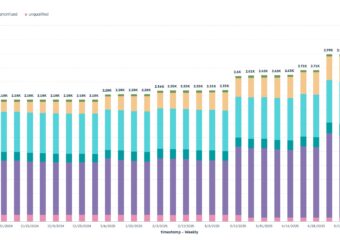Bizarrely, digital marketing departments have often had the lowest-paid position within their ranks be the content write. Your SEO manager was getting paid $85k, your ops strategist were making 102k, your PPC specialist was pulling in $72k. Mangers and directors were making more than that. But your copywriter? You could be paying them $48k a year just fine. Why was this?
From 2010 to 2020 one of the key ways to rank well was to have a blog that would get posted to a couple times a week. Did it matter if the articles were good? Not really. You could follow a formula (certain number of images, particular distribution of links based on total word count, certain occurrences of keywords, etc) and do pretty well— while saying almost nothing of interest to anyone. Sure, you may get a post here or there that generated a lot of traffic and actually was interesting— but that was usually seen as an icing-on-the-cake bonus, not the purpose of content marketing.
Understand: This was not the copywriter’s fault— their bosses were telling them to make these articles. The bosses were doing it because it worked for Google. There were many young writers whose souls slowly died over the tenure of their first few entry level marketing jobs.
Chugging along this waycould be counted on for contributing to significant organic traffic.
Prediction: That’s not going to work
Everyone is up in arms about AI powered content now. Its fun. Its creepy. Its a wild-west that’s going to cause search engines to have to do some serious soul-searching.
What is a search engine’s job? To get people to spend time looking at ads and clicking on ads. How does a search engine do this? By serving up content relevant to the searcher that is interesting and will engage them for some time. So, search engines have always had an interest in trying to serve up the best articles they could. Because there is a limited amount of time in the world to write articles though, often these “fluff content marketing” articles would get shown. It didn’t break the system though, because they might have had something interesting, and the ratio of fluff to actual content wasn’t terrible.
What’s changed? Now, anyone with smattering of API skills and $20 a month can harness an AI bot to crank out articles at a lightning pace. And honestly, they’re not that much worse than the formulaic, dry, fluffy articles that the low-level “content marketers” were putting out.
Why is this changing?
When there are 1500 articles on a topic, of which 4 are good, 50 are ok-ish content fluff, and the remaining 1446 are trash; its pretty easy for Google to throw some ranking cred to the 50 that are ok-ish. They want to give some options, and their searches may be semi interested in.
With AI written articles, there are soon going to be 105,800 articles on the same topic. There still will be the same 4 good articles, but now those 50 ok-ish ones will be lost in the sea of 104,354 AI generated articles, and fairly indistinguishable from them.
Since Google likes money, and they get money the more people look at articles and use search, they are going to focus more on helping users weed out the ok-ish articles.
How to adapt?
So the caveat: This is predicting a future state that isn’t actually true today. But this is what should be done:
– Stop producing ok-ish content. Soon the truly good/insightful/rational stuff is likely going to increase in value from a search perspective.
– Hire out good writers on your content team that weren’t trained on the SEO-calculator-type writing mentality— Maybe hire someone from a non-technical writing background? A hint you’re on the right track: They are no longer the lowest paid employee in the marketing department.
– Stop writing once you’ve finished saying anything useful.

